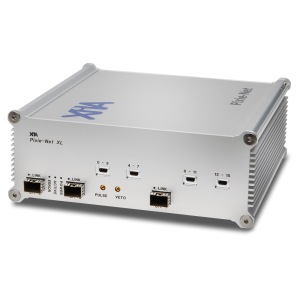Physicists can sync large detector array clocks with White Rabbit

Large detector arrays = Large network headaches
Nuclear physicists who use very large radiation detector arrays can now obtain detector readout electronics that solve a major headache – clock synchronization – while simultaneously solving others due to the costs and complexity of dedicated cabling.
As the size, separation, and locations of detector arrays grow, experimenters face a challenge that grows along with the array: synchronizing timing clocks in many digital detector readout electronics modules to ensure they can match the data from different channels by their time stamps.
Scientists traditionally distribute their clocks and triggers throughout a second network of dedicated cables. (You may, in fact, recognize yourself as the cable wrangler who has to physically plug both ends of hundreds to thousands of cables into the right sockets.) To no one’s surprise, running, organizing, and maintaining twice as many cables adds complexity and cost.
White Rabbit to the rescue
However, hardware based on White Rabbit, the high accuracy profile of the IEEE 1588 Precision Time Protocol (PTP), can help synchronize detectors to high precision and reduce the cost and inconvenience of dedicated cables. PTP and White Rabbit (WR) allow researchers to synchronize clocks by exchanging timing messages over the same Ethernet cable they use to transmit the data.

Pixie-Net XL
XIA implemented White Rabbit technology in the Pixie-Net XL. The same field programmable gate array (FPGA) that processes the digitized detector signals also has a 1G Ethernet interface. Through that interface, the FPGA receives PTP timing messages for on-board clock synchronization and streams out data at high rates. This synchronizes multiple modules to sub-nanosecond precision and enables readout of physically distant detectors, eliminating the need for another set of cables.
Time-of-flight style time resolution performance results show the WR-synchronized detector readout electronics match those of the older “shared clock” approach. Resolutions are ~300 ps FWHM (full width at half maximum) with LaBr3 detectors, independent of the synchronization method. With an idealized signal from a pulser, WR synchronization reached ~90 ps, compared to ~15 ps for the shared clock approach, indicating the performance limit of the Pixie-Net XL’s WR implementation.
XIA has already provided prototype information on its White Rabbit (WR) products under development to the Open Hardware Repository.
White Rabbit (and the Pixie-Net XL) are well-suited for large radiation detector arrays

IceCube Neutrino Observatory (Image credit: Christopher Michel)
The IceCube Neutrino Observatory at the South Pole (depicted in the accompanying image) illustrates the daunting real-world timing and cable problems such very large arrays confront. This lab sits atop a one-kilometer cube array of sensors embedded in ice. IceCube is planning to use WR in an upcoming update.
Similar detector arrays submerged in the Mediterranean Sea and spread across the Tibetan Plateau must contend with similar clock synchronization, and presumably cable management, issues. They, too, are validating WR to reduce timing and cable headaches.
White Rabbit is the future for large arrays.
Get Information about the Pixie-Net XL
Download the paper “Sub-Nanosecond Time Resolution in Time-of-Flight Style Measurements with White Rabbit Time Synchronization” for a description of the Pixie-Net XL and its actual timing performance and measurement results. IEEE members can download a talk based on the paper that XIA gave at the 23rd IEEE Real Time Conference in 2022.
Contact XIA to discuss “early adopter” access to the Pixie-Net XL, its 10G variant without White Rabbit, and its latest WR prototype hardware.